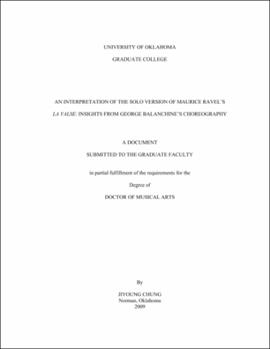| dc.description.abstract | This study focuses on the interrelationship between Ravel\'s music and Balanchine\'s choreography of La Valse in search of insights into the interpretation of the solo piano version. Ravel\'s musical aesthetics are discussed by referencing his biography, musical characteristics, and pianistic style. Historical aspects of La Valse, including the compositional background and cultural and artistic context of the piece, are provided for further insights into the piece. The discussion of five historical choreographies--two Bronislava Nijinska productions during Ravel\'s lifetime, the Paris premier (1929) and her revised production (1931), and then three posthumous productions by Léonide Massine (1950), George Balanchine (1951), and Frederick Ashton (1958)--reveals choreographers\' different approaches to the interrelationship of music and dance in their choreographies of La Valse. Balanchine\'s choreography is examined specifically in terms of the structure of the piece and interpretative insights into effective performance. Performance considerations, including phrasing, touches, tempo flexibility, dynamics, incorporating material in the optional staves, and solutions to technical problems, are discussed in detail. | |
